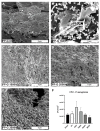Aging of Industrial Polypropylene Surfaces in Detergent Solution and Its Consequences for Biofilm Formation
- PMID: 36904487
- PMCID: PMC10006934
- DOI: 10.3390/polym15051247
Aging of Industrial Polypropylene Surfaces in Detergent Solution and Its Consequences for Biofilm Formation
Abstract
The performance of plastic components in water-bearing parts of industrial and household appliances, often in the presence of harsh environments and elevated temperatures, critically relies on the mechanical and thermal polymer stability. In this light, the precise knowledge of aging properties of polymers formulated with dedicated antiaging additive packages as well as various fillers is crucial for long-time device warranty. We investigated and analysed the time-dependent, polymer-liquid interface aging of different industrial performance polypropylene samples in aqueous detergent solution at high temperatures (95 °C). Special emphasis was put on the disadvantageous process of consecutive biofilm formation that often follows surface transformation and degradation. Atomic force microscopy, scanning electron microscopy, and infrared spectroscopy were used to monitor and analyse the surface aging process. Additionally, bacterial adhesion and biofilm formation was characterised by colony forming unit assays. One of the key findings is the observation of crystalline, fibre-like growth of ethylene bis stearamide (EBS) on the surface during the aging process. EBS is a widely used process aid and lubricant enabling the proper demoulding of injection moulding plastic parts. The aging-induced surface-covering EBS layers changed the surface morphology and promoted bacterial adhesion as well as biofilm formation of Pseudomonas aeruginosa.
Keywords: Pseudomonas aeruginosa; biofilm; detergent; ethylene bis stearamide; filler; liquid aging; polypropylene.
Conflict of interest statement
The authors declare no conflict of interest.
Figures






References
-
- Fink J.K. A Concise Introduction to Additives for Thermoplastic Polymers. Wiley; Hoboken, NJ, USA: 2010.
-
- Pospíšil J. Mechanistic Action of Phenolic Antioxidants in Polymers—A Review. Polym. Degrad. Stab. 1988;20:181–202. doi: 10.1016/0141-3910(88)90069-9. - DOI
-
- Samper M.D., Fages E., Fenollar O., Boronat T., Balart R. The Potential of Flavonoids as Natural Antioxidants and UV Light Stabilizers for Polypropylene. J. Appl. Polym. Sci. 2013;129:1707–1716. doi: 10.1002/app.38871. - DOI
Grants and funding
LinkOut - more resources
Full Text Sources
Miscellaneous

